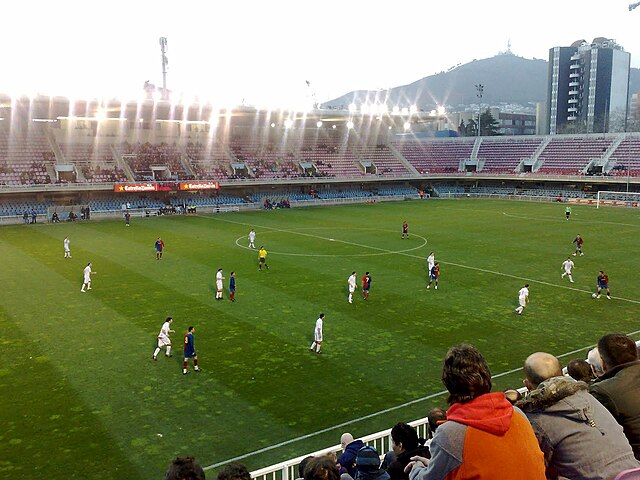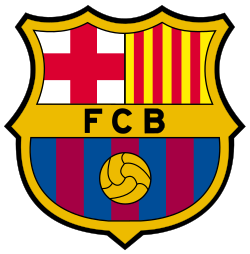Top Qs
Timeline
Chat
Perspective
FC Barcelona Atlètic
FC Barcelona's reserve football team From Wikipedia, the free encyclopedia
Remove ads
Futbol Club Barcelona Atlètic, commonly referred to as Barcelona B, Barça Atlètic or Barça B, is a football team based in Barcelona, Catalonia, Spain, that competes in Segunda Federación – Group 3, the fourth tier of the Spanish league system. Founded in 1970, it is the reserve team of FC Barcelona and it plays its home fixtures at Johan Cruyff Stadium.
Reserve teams in Spain play in the same league system as the senior team, rather than in a reserve team league. They must play at least one level below their main side, and they are not eligible to play in the Copa del Rey.
Remove ads
History
Summarize
Perspective
Espanya Industrial
Founded on 1 August 1934 as Societat Esportiva Industrial Espanya, the club was originally the sports team of the factory with the same name, and its shirt featured blue and white vertical stripes. The company was owned by the family of Josep Antoni de Albert, who was briefly president of Barcelona in 1943; during Albert's presidency the club, now known as Club Deportivo Espanya Industrial, became Barcelona's reserve team and began to play home games at Camp de Les Corts.
Initially, Industrial played in the local regional leagues but, in 1950, it was promoted to Tercera División, reaching Segunda División two years later. In 1953 the club finished as runners-up in both the league and the promotion play-off but, being a nursery club of Barcelona, it was unable to move up a division.
Condal
After winning another promotion play-off in 1956, Espanya Industrial became independent of Barcelona and was renamed Club Deportivo Condal. The club wore blue shirts with two white diagonals stripes.
Condal competed once in La Liga, in the 1956–57 season, being relegated as 16th and last. In 1968, the club rejoined the Barcelona family as its reserve team, and adopted the blaugrana colours.
Barcelona Atlètic/Barcelona B


In 1970, Barcelona president Agustí Montal decided to merge Condal with another club, Atlètic Catalunya, and formed Barcelona Atlètic. Atlètic was founded in 1965 as a result of the merger of two other teams: Catalunya de Les Corts (founded in 1918 as Catalunya Sporting Club) and Fabra Coats (1926).
Under the new denomination the B-team played a total of ten seasons in the second level. At the end of 1988–89 the side returned to Segunda División B – the new third level created in 1977 – after ranking 17th.
In 1990, the team was renamed Barcelona B, but club president Joan Laporta changed the name back to Barcelona Atlètic in 2008. Two years later, his successor Sandro Rosell returned to the previous denomination,[1] until Laporta changed again the name back to Barcelona Atlètic during his second presidential term in 2022.[2]
Former club player Luis Enrique succeeded Pep Guardiola as team manager in the summer of 2008, as the latter was appointed main squad coach.[3] In 2009–10 the team finished second in Group III and returned to the second tier after an absence of 11 years; this was followed by a third-place finish the following campaign, however the team was not eligible for promotion due to its status as a reserve side. They remained in Segunda División for 5 years until their relegation in the 2014–15 season. In 2016–17, Barça B achieved promotion and returned to Segunda División, however, the Catalan side was relegated back to the third division after only one season.
In 2020–21, the team finished as runner-ups in their group and reached the promotion play-offs. Despite an unsuccessful bid for promotion, the team achieved a place in the newly created third division of Spanish football, Primera División RFEF. In 2024–25, the club was relegated to the newly fourth division, Segunda Federación, after 18 years at between the second and third divisions.
Remove ads
Season to season
- 23 seasons in Segunda División
- 4 seasons in Primera Federación/Primera División RFEF
- 23 seasons in Segunda División B
- 1 season in Segunda Federación
- 4 seasons in Tercera División
- 1 season in Categorías Regionales
Remove ads
Honours
- Segunda División B
- Tercera División
- Primera Catalana
- Winners (1): 1972–73
Players
Current squad
- As of 1 September 2025[4]
Note: Flags indicate national team as defined under FIFA eligibility rules; some limited exceptions apply. Players may hold more than one non-FIFA nationality.
From Youth Academy
Note: Flags indicate national team as defined under FIFA eligibility rules; some limited exceptions apply. Players may hold more than one non-FIFA nationality.
Other players under contract
Note: Flags indicate national team as defined under FIFA eligibility rules; some limited exceptions apply. Players may hold more than one non-FIFA nationality.
Out on loan
Note: Flags indicate national team as defined under FIFA eligibility rules; some limited exceptions apply. Players may hold more than one non-FIFA nationality.
Remove ads
Personnel
Current technical staff
Last updated: 26 July 2025
Source: FC Barcelona B
Remove ads
Former coaches
|
|
Remove ads
Records
Summarize
Perspective
- Players in bold are still active with club.
Most appearances
Top scorers
Remove ads
Stadium

On 23 September 1982 the Mini Estadi was inaugurated by Barcelona president Josep Lluís Núñez. Next to the ground there are two training pitches, pitch 3 and 4, which have artificial turf – the latter has a regulation size of 100 x 70 metres and has seating for 1,000 spectators.
Mini Estadi has also hosted games for the Andorra national football team, and the Barcelona Dragons of American football.
As a part of the Espai Barça project, the Mini Estadi was demolished and the Estadi Johan Cruyff was opened to take its place starting in the 2019–20 season. Also, as part of this project the Camp Nou underwent renovation.[10]
Remove ads
La Masia
Inaugurated on 26 September 1966, La Masia is the name given to Barcelona's training facilities located near the Camp Nou in the Les Corts district of Barcelona. It is an ancient country residence built in 1702 and once Camp Nou was inaugurated in 1957, the building was remodelled and extended for use as the club's social headquarters.
In 1979, La Masia became the residence of young players from outside of the city. In the following decades the academy forged several players that would later appear for both the main squad and the Spain national team, Guillermo Amor, Albert Ferrer, Iván de la Peña, Josep Guardiola, Carles Puyol, Gerard López, Xavi, Víctor Valdés, and Andrés Iniesta being amongst the most prominent. Lionel Messi is also an alumnus of La Masia and is one of the most famous players to play for Barcelona as well as the Argentina national football team.[11][12][13]
Notable players
Summarize
Perspective
Note: This list includes players that have appeared in at least 100 top league games, have represented their countries in international level, or both.
 Iván Balliu
Iván Balliu Rey Manaj
Rey Manaj Marc Bernaus
Marc Bernaus Sergio Araujo
Sergio Araujo José Raúl Iglesias
José Raúl Iglesias Lionel Messi
Lionel Messi Srđan Pecelj
Srđan Pecelj Marlon
Marlon Rafinha
Rafinha Macky Bagnack
Macky Bagnack Martin Hongla
Martin Hongla Fabrice Ondoa
Fabrice Ondoa Patrick Suffo
Patrick Suffo Ballou Tabla
Ballou Tabla Merveil Ndockyt
Merveil Ndockyt Alen Halilović
Alen Halilović Goran Vučević
Goran Vučević Urko Pardo
Urko Pardo Diego Almeida
Diego Almeida Alasana Manneh
Alasana Manneh Ilaix Moriba
Ilaix Moriba Edgar Ié
Edgar Ié Anthony Lozano
Anthony Lozano Ottó Vincze
Ottó Vincze Gai Assulin
Gai Assulin Thiago Motta
Thiago Motta Hiroki Abe
Hiroki Abe Tha'er Bawab
Tha'er Bawab Giovani dos Santos
Giovani dos Santos Jonathan dos Santos
Jonathan dos Santos Santiago Fernández
Santiago Fernández Efraín Juárez
Efraín Juárez Lazar Carević
Lazar Carević Ilias Akhomach
Ilias Akhomach Munir El Haddadi
Munir El Haddadi Moha El Yaagoubi
Moha El Yaagoubi Abde Ezzalzouli
Abde Ezzalzouli Chadi Riad
Chadi Riad Jordi Cruyff
Jordi Cruyff Haruna Babangida
Haruna Babangida Ezekiel Bassey
Ezekiel Bassey Samuel Okunowo
Samuel Okunowo David Babunski
David Babunski Antonio Sanabria
Antonio Sanabria Igor Korneev
Igor Korneev Steve Archibald
Steve Archibald Diawandou Diagne
Diawandou Diagne Moussa Wagué
Moussa Wagué Goran Drulić
Goran Drulić Alfi Conteh-Lacalle
Alfi Conteh-Lacalle Lee Seung-woo
Lee Seung-woo Paik Seung-ho
Paik Seung-ho Damià Abella
Damià Abella José Joaquín Albaladejo
José Joaquín Albaladejo Luis Alberto
Luis Alberto Albert Albesa
Albert Albesa Thiago Alcântara
Thiago Alcântara Carles Aleñá
Carles Aleñá Quique Álvarez
Quique Álvarez Guillermo Amor
Guillermo Amor Francesc Arnau
Francesc Arnau Óscar Arpón
Óscar Arpón Esteban Areta
Esteban Areta Mikel Arteta
Mikel Arteta Alejandro Balde
Alejandro Balde Sergi Barjuán
Sergi Barjuán Marc Bartra
Marc Bartra Alberto Botía
Alberto Botía Sergio Busquets
Sergio Busquets Ramón Calderé
Ramón Calderé Lobo Carrasco
Lobo Carrasco Lluís Carreras
Lluís Carreras Marc Casadó
Marc Casadó Albert Celades
Albert Celades Luis Cembranos
Luis Cembranos Thomas Christiansen
Thomas Christiansen Paco Clos
Paco Clos Miquel Corominas
Miquel Corominas Marc Cucurella
Marc Cucurella Iván de la Peña
Iván de la Peña Gerard Deulofeu
Gerard Deulofeu Martín Domínguez
Martín Domínguez Juan José Estella
Juan José Estella Kiko Femenía
Kiko Femenía Albert Ferrer
Albert Ferrer Chico Flores
Chico Flores Andreu Fontàs
Andreu Fontàs Paco Fortes
Paco Fortes Esteve Fradera
Esteve Fradera Sergio García
Sergio García Gabri García
Gabri García Óscar García
Óscar García Roger García
Roger García Luis García
Luis García Salva García
Salva García Sergio García
Sergio García Gavi
Gavi Delfí Geli
Delfí Geli José Gil
José Gil Jordi Gómez
Jordi Gómez Sergi Gómez
Sergi Gómez Nico González
Nico González Álex Grimaldo
Álex Grimaldo Pep Guardiola
Pep Guardiola Dani Güiza
Dani Güiza Gerard Gumbau
Gerard Gumbau Xavi Hernández
Xavi Hernández Sebastián Herrera
Sebastián Herrera Alejo Indias
Alejo Indias Andrés Iniesta
Andrés Iniesta Juan Luis Irazusta
Juan Luis Irazusta Ferran Jutglà
Ferran Jutglà Bojan Krkić
Bojan Krkić Gerard López
Gerard López David Lombán
David Lombán Miguel Ángel Lozano
Miguel Ángel Lozano Manolo
Manolo Quique Martín
Quique Martín Nacho Martín
Nacho Martín Rubén Martínez
Rubén Martínez Paco Martínez
Paco Martínez Josep Martínez
Josep Martínez Jordi Masip
Jordi Masip Luis Milla
Luis Milla Mingo
Mingo Óscar Mingueza
Óscar Mingueza Juan Miranda
Juan Miranda Martín Montoya
Martín Montoya Josep Moratalla
Josep Moratalla Pepe Moré
Pepe Moré Javi Moreno
Javi Moreno Carlos Muñoz
Carlos Muñoz Fernando Navarro
Fernando Navarro Nayim
Nayim Nolito
Nolito Antonio Olmo
Antonio Olmo Cristóbal Parralo
Cristóbal Parralo Patric
Patric Ángel Pedraza
Ángel Pedraza Pedro
Pedro Carles Pérez
Carles Pérez Antonio Pinilla
Antonio Pinilla Oleguer Presas
Oleguer Presas Riqui Puig
Riqui Puig Carles Puyol
Carles Puyol Sandro Ramírez
Sandro Ramírez Pepe Reina
Pepe Reina Oriol Riera
Oriol Riera Sergi Roberto
Sergi Roberto Rubén Rochina
Rubén Rochina Juan Carlos Rojo
Juan Carlos Rojo Oriol Romeu
Oriol Romeu Mikel Roteta
Mikel Roteta Francisco Rufete
Francisco Rufete Abel Ruiz
Abel Ruiz Ilie Sánchez
Ilie Sánchez Tente Sánchez
Tente Sánchez Onésimo Sánchez
Onésimo Sánchez Víctor Sánchez
Víctor Sánchez Pepe Serer
Pepe Serer Adjutori Serrat
Adjutori Serrat Jonathan Soriano
Jonathan Soriano Denis Suárez
Denis Suárez Cristian Tello
Cristian Tello Xavi Torres
Xavi Torres Adama Traoré
Adama Traoré Roberto Trashorras
Roberto Trashorras Víctor Valdés
Víctor Valdés Toni Velamazán
Toni Velamazán Joan Verdú
Joan Verdú Paqui Veza
Paqui Veza Javier Villena
Javier Villena Jordi Vinyals
Jordi Vinyals Lamine Yamal
Lamine Yamal Konrad de la Fuente
Konrad de la Fuente Ronald Araújo
Ronald Araújo Alejandro Marqués
Alejandro Marqués Jeffrén Suárez
Jeffrén Suárez
Remove ads
References
External links
Wikiwand - on
Seamless Wikipedia browsing. On steroids.
Remove ads

